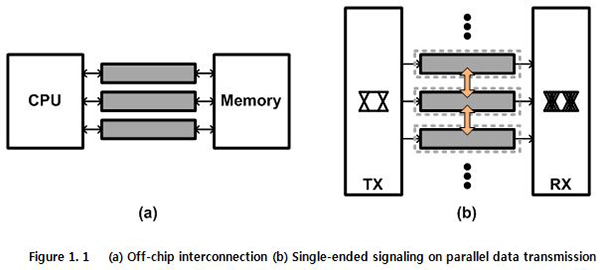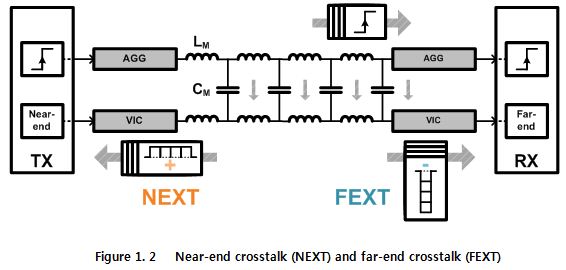| Crosstalk |
As the information technology (IT) development, the expectation of users about IT device has increased dramatically. The demand of users make IT device smaller and faster. Off-chip interconnection connects the central process unit (CPU) chip and the memory chip and is major part of IT device. Therefore, off-chip interconnection with high data rate and low power is required.
Data transmission type of interconnection is classified into serial and parallel. While the serial data transmission uses only one channel, the parallel data transmission uses several channels to achieve high total data rate.
Signaling type of interconnection is classified into single-ended and differential. Differential signaling has noise immune advantage as compared with single-ended signaling. However because differential signaling requires twice lines, the cost increases. To prevent high cost in parallel data transmission, single-ended signaling is widely used on parallel data transmission.
Figure 1 shows a single-ended signaling on parallel data transmission. A channel suffers random noise from adjacent channels by mutual coupling. The random noise is named as crosstalk noise. Because crosstalk noise degrades the quality of received data, it is becoming a major barrier in off-chip interconnection.

The practical channel modeling is configured with many mutual capacitors and inductors as shown in figure 1.2. It is like serialized LMCM elements. Whenever rising transition passes an LMCM element, a positive pulse on near-end and a negative pulse on far-end are generated. Because the movement direction of pulses on near-end is opposite direction of rising transition, the pulses are connected in sequence. In continuous time viewpoint, the sequence of pulses forms a pulse with wide width as near-end crosstalk (NEXT).
In contrast, the movement direction of pulses on far-end is same direction of rising transition. That is, the rising transition and the generated pulse move through parallel lines simultaneously. Therefore whenever additional pulse is generated, the additional pulse is added in pre-generated pulse. As a result, the sum of pulses forms a pulse with high height as far-end crosstalk (FEXT).
While NEXT doesn't affect the transition of victim channel, FEXT affects the transition of victim channel. It makes it difficult to recover the data. In many application, FEXT is more critical than NEXT.

FEXT generates a pulse on victim channel as shown in figure 1.3. Because the pulse and transferred data through victim channel are superposed at the receiver, the pulse affects the transition timing of the transferred data. As a result, the transition timing of data is changed at the receiver side and the eye diagram is degraded. The jitter of degraded eye is called by crosstalk induced jitter (CIJ).
CIJ has the different value as the data pattern between two channels. If the data of channel 1 (CH1) has a transition and the data of channel 2 (CH2) maintains a previous data, a FEXT pulse by CH1 is only generated on CH2. The transition timing of CH1 is not changed because the pulse by CH2 does not exist. It is called by static mode. If data of CH1 and CH2 have transitions of opposite direction, the generated FEXT pulses support the transitions at the each channel. The transition timing of both CH1 and CH2 is earlier than static mode. It is called by odd mode. If data of CH1 and CH2 have transitions of same direction, the generated FEXT pulses interrupt the transitions at the each channel. The transition timing of both CH1 and CH2 is later than static mode. It is called by even mode.
In practical, because random data are transferred through channels, three modes are generated all. On the eye diagram, discrete transition lines signify each mode of CIJ. The time difference between odd mode and even mode is maximum CIJ.

At the receiver, the transferred data is recovered by sampling as shown in figure 1.4. To guarantee correct recovery, the center of data eye is recommended as sampling point. However as data eye is degraded by CIJ, the sampling margin is reduced. The reduced sampling margin causes the fail of data recovery. As the sampling margin is reduced, the number of errors increases and bit error rate (BER) increases. That is, because the degradation of eye diagram by CIJ causes in-crease of BER, CIJ should be compensated.
In single-end signaling on parallel data transmission, crosstalk compensation block is needed equal number with channel number. Because many blocks are used, small area and low power per a block are required.



